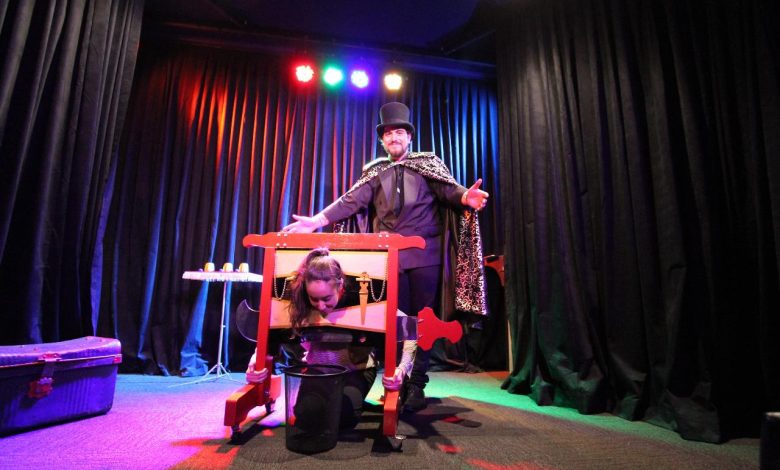The Role of Mystery and Suspense in Magic Shows

Magic shows have captivated audiences for centuries, weaving an intricate web of illusion, wonder, and surprise. At the heart of every great performance lies two crucial elements: mystery and suspense. These psychological tools are fundamental in keeping an audience on the edge of their seats, eagerly anticipating the next trick while trying to unravel the impossible. This interplay between mystery and suspense is not only what makes magic shows thrilling but also what elevates them into an unforgettable experience.
The Art of Mystery in Magic
Mystery is, perhaps, the most integral component of any magic performance. Without it, magic would simply be a series of tricks rather than an enchanting performance that sparks awe and amazement. Mystery, in the context of a magic show, involves the magician’s ability to conceal the methods behind their illusions. It’s about creating an atmosphere where the audience feels as though they’ve glimpsed the impossible, only to have it quickly vanish before they can understand how it was done.
A master magician knows how to build layers of mystery around their acts. Whether it’s performing a classic card trick or pulling a rabbit out of a hat, the magician’s role is not just to perform the trick, but to engage the audience’s imagination. For instance, when a magician pulls a seemingly ordinary item from thin air, the audience is left with a sense of disbelief, wondering how such a thing could be possible. This mystery, when crafted carefully, creates an emotional bond between the performer and the audience. It fosters a sense of wonder that is much more than mere trickery—it becomes a shared experience of curiosity and amazement.
The magician’s role in maintaining mystery extends beyond just the tricks themselves. Their persona, mannerisms, and interactions with the audience all contribute to keeping the secrets hidden. The use of misdirection is a key tool in a magician’s arsenal. This technique involves directing the audience’s attention away from the action that is critical to the illusion. By doing so, the magician ensures that the mystery remains intact and the audience is left guessing how the trick was accomplished.
The Power of Suspense
While mystery sets the stage for awe, suspense keeps the audience engaged throughout the performance. Suspense is what makes magic shows so compelling—it’s the tension that builds as the audience waits for the magician to reveal their next move. A magician’s ability to build suspense is essential in creating a captivating atmosphere that keeps the audience hooked from start to finish.
Suspense in a magic show is often created through timing and pacing. A magician may slowly draw out a moment, extending the anticipation just long enough to make the audience feel as though they are on the brink of discovering the secret. For example, before unveiling the outcome of a trick, a magician might pause, looking at their audience with an intense gaze, allowing the room to fall silent. This pause, though brief, heightens the tension and magnifies the thrill when the trick is finally revealed.
The magician’s use of storytelling is also vital in maintaining suspense. A great magic show is not just a series of isolated tricks; it is an engaging narrative that unfolds. As the show progresses, the audience becomes emotionally invested in the magician’s journey. Whether it’s a story of a daring escape or a quest to unlock a mysterious secret, the magician weaves a tale that builds with each trick, keeping the suspense alive until the very end.
Moreover, suspense can also be created by having the audience participate in the magic. When the magician involves spectators directly, it creates an added layer of tension. The uncertainty of what will happen next—will the trick go as planned?—intensifies the suspense. The audience is no longer just passive observers but active participants in the unfolding mystery, amplifying their emotional investment in the performance.
Balancing Mystery and Suspense
While mystery and suspense are individually powerful, the true art of a magic show lies in the magician’s ability to balance both elements. Too much mystery without suspense can leave an audience intrigued but ultimately disengaged, as they may feel lost in a sea of unanswered questions. Conversely, too much suspense without mystery can result in a show that is thrilling but ultimately unsatisfying, as the audience will eventually tire of waiting for a revelation that never comes.
A magician achieves this balance by carefully orchestrating the flow of the performance. In the early stages, they may introduce simple tricks that are easy to follow, gradually building both mystery and suspense as the performance progresses. With each trick, the complexity increases, keeping the audience guessing while maintaining the tension. The ultimate payoff is often the culmination of both mystery and suspense, as the final trick leaves the audience in awe and wonder.
For example, imagine a magician performing a card trick where they seemingly read the minds of the audience. The mystery comes from the magician’s ability to correctly identify the chosen card without anyone knowing how it was done. But as the magician slowly reveals the card, creating suspense with each passing second, the audience is filled with a sense of anticipation. This combination of mystery and suspense creates a thrilling climax that leaves the audience in awe.
The Psychological Impact of Mystery and Suspense
The psychological effect of mystery and suspense in magic is profound. Humans are naturally curious, and our brains are wired to seek out patterns and explanations for the unknown. In a magic show, the magician plays on this natural tendency, offering just enough information to keep the audience’s curiosity piqued while withholding enough to keep them intrigued.
The suspense created during the performance has a direct impact on the audience’s emotional state. As tension builds, so does the excitement, and the eventual resolution—when the trick is revealed—delivers a rush of satisfaction. The emotional highs and lows that the audience experiences during the show are what make magic so uniquely captivating. They feel a sense of personal involvement in the unfolding drama, even though they are not actively participating.
Additionally, the sense of wonder and amazement that comes from witnessing a seemingly impossible trick taps into deeper psychological desires for escapism and excitement. Magic offers a temporary break from the mundane, allowing the audience to experience a world where the ordinary rules of reality no longer apply.
Conclusion
Mystery and suspense are not merely additives in a magic show; they are its core. They shape the audience’s emotional journey, weaving together intrigue, tension, and amazement into a cohesive performance. Through the artful manipulation of mystery, magicians create illusions that captivate and engage, while suspense keeps audiences on the edge of their seats, eagerly awaiting the next revelation. Together, these elements make magic shows a powerful form of entertainment—one that taps into our most primal desires for curiosity, excitement, and wonder. As long as these elements remain at the heart of magic, the allure of the unknown will continue to enchant audiences for years to come.






